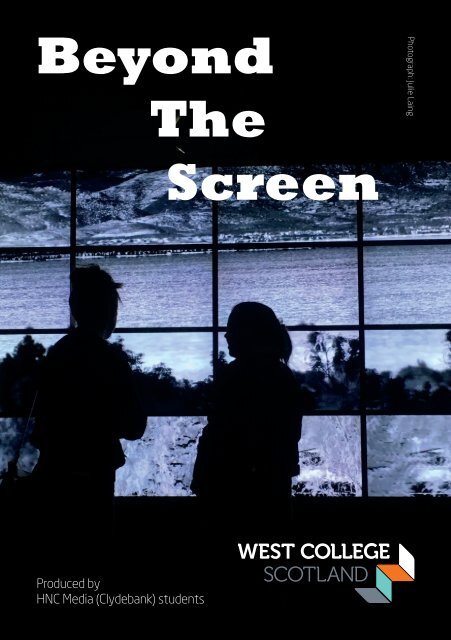Create successful ePaper yourself
Turn your PDF publications into a flip-book with our unique Google optimized e-Paper software.
<strong>Beyond</strong><br />
The<br />
Photograph: Julie Laing<br />
<strong>Screen</strong><br />
Produced by<br />
<strong>HNC</strong> <strong>Media</strong> (<strong>Clydebank</strong>) <strong>students</strong>
SHOWCASE<br />
of West College Scotland (<strong>Clydebank</strong>) student work<br />
Preview Tuesday 20 June 1830 - 2000<br />
Open to public Wednesday 21 June 1200 - 1700<br />
Awestruck Gallery, 75 Kilbowie Rd, <strong>Clydebank</strong> G81 1BL<br />
Kevin Murney NC Photography<br />
Kevin Murney NC Photography<br />
Angela Jacobs NC Interior Design and Architecture<br />
Frank Graham NC Photography
CONTENTS<br />
25-26 United Passions Review<br />
Letter from <strong>the</strong> Editor<br />
<strong>Beyond</strong> <strong>the</strong> <strong>Screen</strong> is a student magazine made by <strong>students</strong> for <strong>students</strong>. This publication<br />
brings toge<strong>the</strong>r a collection of articles on topics surrounding <strong>the</strong> current media industry.<br />
It hopes to bring light to some issues that are plaguing <strong>the</strong> film industry today such as<br />
LGBT+ under-representation and <strong>the</strong> unoriginality in Hollywood.<br />
I would like to thank everyone who was involved in creating this magazine. I would also<br />
like to thank you, <strong>the</strong> reader, for giving this a read. I hope that you find <strong>the</strong>se articles<br />
enjoyable and informative.<br />
All <strong>the</strong> best.<br />
Samantha Carmichael<br />
Discussion<br />
2-3 Humans vs Technology<br />
4-6 Originality in Hollywood<br />
6-7 Horror is Dead<br />
8-9 A <strong>Screen</strong> Odyssey<br />
9-12 Film Marketing<br />
Culture<br />
13-15 Anime’s influence on<br />
Western Culture<br />
16-19 LGBTQI in Cinema<br />
20-23 Taylor Bennett’s Broad<br />
Shoulders<br />
Theater<br />
23-24 Evolution of Theatre<br />
Review
Discussion Page 2<br />
Do Films Predict<br />
<strong>the</strong> Future?<br />
With modern technology expanding at such a rapid pace, are films<br />
and television responsible for encouraging inventors to make fantasy<br />
a reality?<br />
By Garry Bennett<br />
We have a habit of taking<br />
our current lives for granted.<br />
This extends to modern<br />
technology. But what we<br />
take for granted was once<br />
considered fantasy, a fable<br />
of a far future that no-one<br />
expected to see. In some<br />
cases, however, people do<br />
see. I’m talking about TV<br />
and film predicting <strong>the</strong><br />
future.<br />
Of course, some things<br />
that were predicted haven’t<br />
happened; I’m still<br />
anticipating <strong>the</strong> arrival of<br />
<strong>the</strong> ‘back to <strong>the</strong> future’<br />
hoverboard any day, but<br />
TV and film have had an<br />
undeniable impact on present<br />
technology. One series<br />
from <strong>the</strong> 1960s predicted<br />
many future technological<br />
leaps; that program was<br />
‘Star Trek’.<br />
One man who lived during<br />
<strong>the</strong> run of <strong>the</strong> original<br />
series of ‘Star Trek’ was<br />
Eric Spence. He said: “I<br />
recently watch one of <strong>the</strong><br />
original Star Trek episodes.<br />
It was a standard episode<br />
of <strong>the</strong> space opera but I<br />
realised how accurately <strong>the</strong><br />
technology in that universe<br />
predicted what we would<br />
eventually have. The most<br />
obvious is <strong>the</strong> handheld<br />
communicator which became<br />
<strong>the</strong> modern day mobile<br />
phone.” The show also<br />
went on to predict tablets<br />
and even video calls.
Page 3<br />
Discussion<br />
We are now over 50 years<br />
away from <strong>the</strong> original series<br />
of ‘Star Trek’ but films<br />
that were released more<br />
recently have done a good<br />
job of keeping up with<br />
foretelling. Former media<br />
student Andrew Lowing<br />
said:<br />
“I think that <strong>the</strong> way technology<br />
has caught up with<br />
what we once perceived<br />
as <strong>the</strong> future is remarkable.<br />
I remember watching<br />
‘Minority Report’ (2002)<br />
and thinking how amazing<br />
it would be to have touch<br />
screen computers. Now it<br />
is a very common technology<br />
that one forgets that it<br />
was once a fantasy.”<br />
So what kinds of technology<br />
do current film and tv<br />
shows predict we may have<br />
in <strong>the</strong> future. In season<br />
2 of <strong>the</strong> brilliant ‘Black<br />
Mirror’, a woman who is<br />
grieving after <strong>the</strong> death of<br />
her husband downloads<br />
an app that can create a<br />
facsimile of him based on<br />
his online activity, such as<br />
social media posts. This in<br />
itself is beyond <strong>the</strong> reach<br />
of current technology, but<br />
this is <strong>the</strong> opening of <strong>the</strong><br />
rabbit hole.<br />
The app <strong>the</strong>n offers her an<br />
upgrade to her ‘package’<br />
which will allow <strong>the</strong> AI to<br />
phone her directly and will<br />
possess <strong>the</strong> voice of her<br />
husband. This is a creepy<br />
prospect of what is still<br />
well within <strong>the</strong> bounds of<br />
our technology. The next<br />
upgrade for <strong>the</strong> package<br />
raises moral complications<br />
as <strong>the</strong> company sends <strong>the</strong><br />
grieving wife a full sized<br />
and fully functional version<br />
of her husband. It speaks,<br />
thinks and has sex with <strong>the</strong><br />
wife before she starts to<br />
realise <strong>the</strong> consequences of<br />
her choices.<br />
Technology like this could<br />
lead down a dark road for<br />
humanity. At what stage of<br />
this process would we start<br />
to consider this new ‘being’<br />
an actual life form? There<br />
are also seedy implications<br />
of this technological development.<br />
We all know that<br />
<strong>the</strong>re are people out <strong>the</strong>re<br />
who would have no quarrel<br />
with hacking someone and<br />
stealing <strong>the</strong>ir internet history.<br />
What if someone was<br />
to hack a celebrity and sell<br />
<strong>the</strong>ir ‘personality’ online to<br />
those truly lonely weirdoes<br />
out <strong>the</strong>re in <strong>the</strong> real world?<br />
Grief-stricken individuals<br />
suffering from rejection or<br />
coping with death would<br />
find it hard to pass up <strong>the</strong><br />
opportunity.<br />
We are all human after all,<br />
but maybe in 100 years’<br />
time, we won’t be anymore.<br />
Is this where technology<br />
is leading us? To a world<br />
where it surpasses our<br />
humanity? Or are <strong>the</strong><br />
developments predicted<br />
just works of fiction that<br />
will never see <strong>the</strong> light of<br />
day? One can only hope we<br />
remember to think before<br />
we click.
Discussion Page 4<br />
Unoriginality in<br />
Hollywood?<br />
More and more film releases <strong>the</strong>se days feel more and more<br />
repetitive. This makes us ask <strong>the</strong> question; has Hollywood run out of<br />
ideas?<br />
By Ronan Ferris<br />
It has long been felt that<br />
a lack of originality exists<br />
within Hollywood. When<br />
looking at many of <strong>the</strong><br />
films released in <strong>the</strong> last<br />
ten years, for example,<br />
it is clear to see that<br />
prequels, sequels, and<br />
remakes truly dominate<br />
<strong>the</strong> film industry. The<br />
highest grossing films of<br />
2016 included ‘Captain<br />
America: Civil War’,<br />
‘Finding Dory’, and<br />
‘Batman v Superman:<br />
Dawn of Justice’. While<br />
for <strong>the</strong> most part <strong>the</strong>re<br />
can be no disputing <strong>the</strong><br />
quality of <strong>the</strong>se films, <strong>the</strong>y<br />
each definitively represent<br />
<strong>the</strong> reboot state of<br />
creativity in Hollywood.<br />
A number of large-scale<br />
films were released in<br />
2016. But, instead of<br />
feeling like a groundbreaking<br />
year for cinema<br />
and storytelling, it felt<br />
more like Hollywood’s<br />
desperate attempt to<br />
Fan Artwork: Lego Batman vs Superman<br />
cash in and tug on <strong>the</strong><br />
heartstrings of fans who<br />
will certainly flock to <strong>the</strong>ir<br />
local cinema for a dose<br />
of nostalgia. Nostalgia is<br />
<strong>the</strong> key word here. Ra<strong>the</strong>r<br />
than taking creative risks,<br />
directors are opting to<br />
play it safe. With classic<br />
films such as ‘Star Wars’,<br />
‘Rocky’ and ‘Jurassic<br />
Park’ receiving <strong>the</strong> new<br />
sequel/prequel treatment,<br />
it has become all too<br />
common for directors to<br />
simply recycle <strong>the</strong> plot<br />
from previous films and<br />
include familiar faces and
Page 5<br />
Discussion<br />
Live Action Remakes: Beauty and <strong>the</strong> Beast (2017)<br />
locations in <strong>the</strong> hope that<br />
it will hide this strategy.<br />
It should be noted that<br />
when an established<br />
franchise takes on a new<br />
director, considerable<br />
pressure is placed upon<br />
<strong>the</strong>m. It takes a lot for<br />
a director to balance<br />
fan expectation whilst<br />
also promising <strong>the</strong>m<br />
something fresh and<br />
exciting. I’m certain J.J.<br />
Abrams could attest to<br />
that.<br />
The biggest culprit in all<br />
of this is Disney. <strong>HNC</strong><br />
<strong>Media</strong> student Sinead<br />
Keogh had this to say:<br />
“In <strong>the</strong> last few years I<br />
do think <strong>the</strong> film industry<br />
has struggled. I honestly<br />
don’t think <strong>the</strong>re’s been<br />
much to get excited about.<br />
In terms of originality it’s<br />
obvious <strong>the</strong>re’s no creative<br />
drive. Disney, for example,<br />
has been doing live-action<br />
remakes of <strong>the</strong>ir animated<br />
films. While <strong>the</strong>y might be<br />
successful films <strong>the</strong>re’s no<br />
denying it. It’s not exactly<br />
original.”<br />
Disney is one of <strong>the</strong><br />
world’s largest media<br />
conglomerates, but it’s<br />
no exaggeration that<br />
<strong>the</strong>y’re on <strong>the</strong>ir last limb<br />
creatively. The majority<br />
of <strong>the</strong>ir stories are based<br />
on old fairytales and<br />
books. In fact, a lot of <strong>the</strong><br />
Disney Princess stories<br />
come from Grimm’s<br />
tales and o<strong>the</strong>r pieces of<br />
folklore. The problem<br />
with that is <strong>the</strong>re are now<br />
no more stories to tell,<br />
hence, <strong>the</strong> increase in<br />
live action remakes and<br />
endless sequels stemming<br />
from acclaimed original<br />
films such as Finding<br />
Nemo, Monsters Inc., and<br />
Toy Story, to name a few.<br />
Disney clearly hasn’t heard<br />
of <strong>the</strong> term ‘too much<br />
of a good thing’ if <strong>the</strong>ir<br />
recent announcements<br />
are anything to go by.<br />
They revealed that, as<br />
well as releasing a new<br />
Star Wars film every year,<br />
three Marvel films will<br />
be released annually as<br />
<strong>the</strong> studio begins phase
Discussion Page 6<br />
three of <strong>the</strong>ir superhero<br />
franchise. In doing<br />
this, Disney risks over<br />
saturation. Think about it.<br />
When Star Wars Episode<br />
7 was released it was truly<br />
an event; however, by<br />
releasing an instalment<br />
annually Disney risks it<br />
becoming commonplace,<br />
just as <strong>the</strong> Marvel films<br />
have become.<br />
So, how can things<br />
change? Well, we have to<br />
start with ourselves. We<br />
can’t blame Hollywood for<br />
<strong>the</strong>ir lack of ideas; after<br />
all, we aren’t stopping<br />
<strong>the</strong>m. If we stopped<br />
buying tickets to every<br />
reboot, sequel, and spinoff<br />
that’s released, <strong>the</strong>y<br />
wouldn’t be made. Simple<br />
as that. We must continue<br />
to support filmmakers<br />
who are providing us<br />
with new and original<br />
experiences. Instead of<br />
putting more money in<br />
Disney’s pocket perhaps<br />
we should support <strong>the</strong><br />
unique voices in <strong>the</strong><br />
industry like your Andrea<br />
Arnolds or your Lynne<br />
Ramsays - unless <strong>the</strong>y<br />
start repeating <strong>the</strong>mselves.<br />
Horror is alive.<br />
Horror is dying.<br />
Horror is dead.<br />
Is <strong>the</strong> ultimate thrill-ride genre dead? It’s a<br />
question all film goers ask <strong>the</strong>mselves every<br />
time <strong>the</strong>y see a new horror movie debuting in<br />
<strong>the</strong>atres. Let’s take an indepth look to see if<br />
horror is dead or not.<br />
By Scott Mcmillan<br />
Some would say it’s been<br />
well over 25 years since<br />
a good, original horror<br />
film was made. Over<br />
<strong>the</strong> past 25 years we’ve<br />
seen remakes of cult<br />
films such as ‘The Town<br />
That Dreaded Sundown’,<br />
‘Nightmare On Elm Street’<br />
and ‘Halloween’. Little<br />
good and a lot of bad. I<br />
put this down to an overreliance<br />
on jump scares or<br />
“fear frequency” Don’t<br />
know what it is? It’s a<br />
low-frequency sound<br />
that <strong>the</strong> human ear can’t<br />
hear but it causes <strong>the</strong><br />
brain to become scared.<br />
The frequency is meant<br />
to be heard before<br />
earthquakes happen. A<br />
lot of fans are sceptical<br />
about it’s use, but it<br />
might surprise you to<br />
know that this is edited
Page 7<br />
Discussion<br />
into many horror films.<br />
Avid horror fans have<br />
spoken out against this<br />
and <strong>the</strong> use of jump scares<br />
in modern horror films.<br />
Are <strong>the</strong>y a big negative in<br />
<strong>the</strong> genre? Recently at <strong>the</strong><br />
Glasgow Film Festival, we<br />
caught up with a horror<br />
fan called Liam to give us<br />
his thoughts on <strong>the</strong>se two<br />
“cheap tricks”. He told us:<br />
“I’m not really against<br />
fear frequency. I think it’s<br />
actually pretty cool that<br />
a sound we can’t hear at<br />
a certain frequency can<br />
make you anxious. I just<br />
think it doesn’t take a<br />
genius to throw a “scary”<br />
face on a screen for a<br />
couple seconds and I just<br />
think it cheapens an often<br />
pretty good horror film.”<br />
And <strong>the</strong> point so far?<br />
There’s a lot of bad in<br />
<strong>the</strong> modern horror film<br />
genre. At <strong>the</strong> same time,<br />
<strong>the</strong>re is a lot of good.<br />
For example, modern<br />
day horror movies such<br />
as ‘Insidious’, ‘The Boy’<br />
and ‘The Marble Hornets<br />
series prove horror is still<br />
alive - in a good way.<br />
If you take an overall look<br />
at <strong>the</strong> film industry in<br />
2017, you’ll notice every<br />
genre relies on remake<br />
after remake. It’s a general<br />
media strategy to increase<br />
profit. Even video games<br />
have remakes camouflaged<br />
as remasters; and albums<br />
are re-released as “digital<br />
deluxe” copies.<br />
Horror isn’t all bad, but it<br />
is a bit lazy. Repeat instead<br />
of create that has become<br />
<strong>the</strong> motto of many<br />
creative formats.<br />
So, to answer <strong>the</strong> question,<br />
horror is not dead, but it is<br />
sleepwalking.
Discussion Page 8<br />
A <strong>Screen</strong> Odyssey<br />
Movie makers take inspiration from many sources. However, is<br />
it possible that what <strong>the</strong>y create can actually change <strong>the</strong> world<br />
around <strong>the</strong>m?<br />
By Scott Dorman<br />
Just fourteen months<br />
prior to Neil Armstrong’s<br />
iconic “small step for<br />
man” in 1969, MGM<br />
Studios released Stanley<br />
Kubrick’s ‘2001: A Space<br />
Odyssey’, which promised<br />
- and undoubtedly<br />
delivered - “a majestic<br />
visual masterpiece”.<br />
Its production took<br />
just over three years to<br />
complete and, thanks to<br />
<strong>the</strong> revolutionary filming<br />
techniques employed, it<br />
captured imaginations and<br />
to this day stands as one<br />
of <strong>the</strong> greatest science<br />
fiction features of all time.<br />
Kubrick recruited British<br />
David Bowman: Portrayed by Keir Dullea in 1969’s ‘2001: A Space Odyssey<br />
science fiction (and fact)<br />
writer and inventor Arthur<br />
C. Clarke in developing<br />
a scientifically sound<br />
screenplay, with <strong>the</strong> author<br />
simultaneously producing<br />
a literary version of <strong>the</strong><br />
story. ‘2001’ is a cryptic,<br />
trippy tale spanning man’s<br />
evolution from primitive<br />
ape-man to space-faring<br />
humans first encountering<br />
alien life. Each stage in <strong>the</strong><br />
evolutionary advancement<br />
is curiously overseen by <strong>the</strong><br />
mysterious, haunting black<br />
monolith, which - as is<br />
argued by many a YouTube<br />
user - could possibly<br />
represent <strong>the</strong> cinema<br />
screen itself. Is Kubrick<br />
using it to emphasise <strong>the</strong><br />
transformative power of<br />
cinema? Almost 50 years<br />
on, <strong>the</strong> film is still massively<br />
influential; former<br />
US President Barack<br />
Obama named it one of<br />
his favourites, saying it<br />
“captures <strong>the</strong> grandeur and<br />
scale of <strong>the</strong> unknown”.
Page 9<br />
Discussion<br />
Daniel Blake: Portrayed by Dave Johns in 2016’s I, Daniel Blake<br />
The decades following <strong>the</strong><br />
film’s release have spawned<br />
a wave of conspiracy<br />
<strong>the</strong>ories claiming that it<br />
was produced as part of a<br />
‘faked-moon-landing coverup’,<br />
in which Kubrick<br />
supposedly manufactured<br />
<strong>the</strong> iconic historical footage<br />
in a recreated lunar surface<br />
on a soundstage. Whatever<br />
your personal take, <strong>the</strong>re<br />
is little room for doubt<br />
about <strong>the</strong> massive influence<br />
that film - or even just <strong>the</strong><br />
screen in general - has over<br />
our lives.<br />
Some films are very direct<br />
in <strong>the</strong>ir approach to<br />
influencing change, like<br />
2006’s ‘An Inconvenient<br />
Truth’, in which former<br />
US Presidential candidate<br />
Al Gore brought <strong>the</strong> issue<br />
of climate change into<br />
<strong>the</strong> global spotlight. The<br />
film’s premise is simple -<br />
Gore stands in front of a<br />
powerpoint and delivers<br />
<strong>the</strong> facts. Despite having<br />
heard about ‘<strong>the</strong> hole in <strong>the</strong><br />
ozone’ since I was a child,<br />
‘An Inconvenient Truth’<br />
was my first real insight<br />
to <strong>the</strong> issue. O<strong>the</strong>r films,<br />
like ‘La Haine’ - set amidst<br />
a background of social<br />
unrest and racial tension in<br />
nineties Paris - take a more<br />
subversive approach. The<br />
low budget film follows<br />
twenty-four hours in <strong>the</strong><br />
life of a trio of young men<br />
in a troubled housing estate<br />
on <strong>the</strong> cusp of <strong>the</strong> French<br />
capital. It became a box<br />
office hit and made such a<br />
powerful statement that <strong>the</strong><br />
<strong>the</strong>n Prime Minister, Alain<br />
Juppe, ordered a mandatory<br />
screening for his cabinet<br />
ministers.<br />
We’re not stuck for choice.<br />
Films like ‘I, Daniel Blake’<br />
by Ken Loach - which<br />
raises deabte around <strong>the</strong><br />
extent of <strong>the</strong> effects of<br />
government reform to<br />
<strong>the</strong> benefits system in<br />
Britain was discussed in<br />
Parliament. And ‘Blood<br />
Diamond’ - which unveiled<br />
<strong>the</strong> brutality behind <strong>the</strong><br />
diamond trade in Sierra<br />
Leone - spoke to an<br />
audience well beyond <strong>the</strong><br />
confines of <strong>the</strong> picture hall.<br />
Can film change <strong>the</strong> world?<br />
Kubrick - who was always<br />
ahead of <strong>the</strong> curve -<br />
seemed to think so. And I<br />
do too. Do you?
Discussion Page 10<br />
Can Marketing<br />
Make A Movie?<br />
Does advertising really have <strong>the</strong> power to affect <strong>the</strong> success of a movie<br />
before audiences have had <strong>the</strong> chance to see it?<br />
By Scott McLeod<br />
There are a number of<br />
things that can lead to a<br />
movie being successful:<br />
<strong>the</strong> performances of <strong>the</strong><br />
actors, <strong>the</strong> story or even<br />
<strong>the</strong> anticipation of a built<br />
in fan base. But no one<br />
can deny <strong>the</strong> importance<br />
of marketing.<br />
For certain movies<br />
marketing can make or<br />
break it. Smaller movies<br />
rely on a good marketing<br />
campaign to spread<br />
interest. It can also help a<br />
movie based on existing<br />
material gain interest<br />
from people outside <strong>the</strong><br />
pre-established fan base.<br />
A recent example of<br />
<strong>the</strong> latter is ‘Deadpool’.<br />
Strangely, in <strong>the</strong> comic<br />
book world, people<br />
still had doubts about<br />
‘Deadpool’ as a film. A<br />
character that would be<br />
unknown to mainstream<br />
audiences and would<br />
Deadpool: Christmas Promotional Poster
Page 11<br />
“I felt<br />
like it was<br />
something I<br />
should see.”<br />
attract an ‘R’ (UK 18)<br />
rating for a faithful<br />
adaptation seemed like a<br />
risky project for Fox.<br />
However, <strong>the</strong> film version<br />
managed to generate<br />
interest even before it was<br />
made when test footage<br />
was leaked online. In two<br />
minutes fans and nonfans<br />
got a taste of what a<br />
‘Deadpool’ movie could<br />
be. Social media buzz led<br />
to <strong>the</strong> studio greenlighting<br />
<strong>the</strong> project and played a<br />
big part in <strong>the</strong> marketing,<br />
and emojis were used in<br />
poster.<br />
Ryan Reynold’s dedication<br />
to <strong>the</strong> character of<br />
Deadpool helped. He<br />
made multiple appearances<br />
in character including a<br />
very well played April<br />
Fool’s Day appearance to<br />
announce <strong>the</strong> R rating.<br />
It clearly helped as<br />
‘Deadpool’ would go on to<br />
be one of 2016’s highest<br />
grossing films. It made<br />
$363 million domestically<br />
and $420 million<br />
internationally. Audiences<br />
Discussion<br />
here seemed to react<br />
positively. A media student<br />
told me: “I knew very little<br />
about ‘Deadpool’ before it<br />
came out’ but after seeing<br />
some of <strong>the</strong> trailers and<br />
<strong>the</strong> poster I felt like it was<br />
something I should see”.<br />
A fan of <strong>the</strong> comic books<br />
said: “I probably would<br />
have gone to see it anyway,<br />
but <strong>the</strong> ads just made me<br />
see that <strong>the</strong> character was<br />
being done correctly.”<br />
On <strong>the</strong> opposite end<br />
of <strong>the</strong> scale, ‘The Iron<br />
Giant’ received very little<br />
marketing at all. Brad<br />
Bird’s directorial debut<br />
was a case of being in <strong>the</strong><br />
Deadpool: Valentine’s Day Promotional Poster
Discussion Page 12<br />
wrong place at <strong>the</strong> wrong<br />
time. It was released less<br />
than a year after Warner<br />
Bros last animated movie<br />
failed financially and<br />
critically. Warner Bros had<br />
lost all interest in animated<br />
movies, and was basically<br />
forced to release ‘The<br />
Iron Giant’ after some of<br />
<strong>the</strong>ir most successful test<br />
screenings. The production<br />
company also cancelled a<br />
potential deal with Burger<br />
King. A big part of <strong>the</strong><br />
target audience for any<br />
animated film is children<br />
and this deal could have<br />
been a way to appeal to its<br />
target audience so this was<br />
a blow.<br />
Despite very positive<br />
reviews, ‘The Iron Giant’<br />
only made $23 million<br />
domestically and $8<br />
million internationally,<br />
resulting in an overall<br />
gross of $31 million on a<br />
$70 million budget. It was<br />
only later through DVD<br />
sales that <strong>the</strong> studio made<br />
most of its money back.<br />
Given <strong>the</strong>se two examples,<br />
it’s easy say that it’s all<br />
down to marketing, but<br />
how can we be sure? How<br />
much more money would<br />
Iron Giant have made if it<br />
Iron Giant: Promotional Poster<br />
had been marketed more<br />
effectively? Just because<br />
people know about film<br />
doesn’t mean <strong>the</strong>y will<br />
want to see it.<br />
There are examples of<br />
good movies that were<br />
marketed well but weren’t<br />
successful. At <strong>the</strong> end of<br />
<strong>the</strong> day a good marketing<br />
campaign can make a<br />
world of difference,<br />
but it can’t guarantee a<br />
blockbuster.
Page 13<br />
Anime’s Influence on<br />
Western Culture<br />
Culture<br />
The Anime phenomenon has taken over Western cinemas with live action remakes,<br />
such as ‘Ghost in <strong>the</strong> Shell’, and cinematic movie releases from mainstream series,<br />
such as ‘Fairy Tail’ and ‘Naruto’. But is Japanese animation influencing <strong>the</strong><br />
animation industry in America?<br />
By Robyn Abisoye<br />
Japan is a country with<br />
a unique culture and has<br />
made a huge contribution<br />
to <strong>the</strong> world over <strong>the</strong><br />
years. The most iconic<br />
contribution is none<br />
o<strong>the</strong>r than what <strong>the</strong><br />
world knows as “Anime”.<br />
Originally known as<br />
“Japanimation”, <strong>the</strong> genre<br />
is associated with <strong>the</strong><br />
original television series<br />
and movies which all<br />
cover every genre from<br />
fantasy to romance to<br />
horror. Anime series are<br />
populated with <strong>the</strong> most<br />
interesting characters and<br />
unique storylines that<br />
Anime fans of all ages<br />
from all walks of life have<br />
loved. Since its origin in<br />
Japan, it has expanded all<br />
of over <strong>the</strong> world and has<br />
become a part of modern<br />
culture.<br />
Gateway anime such<br />
‘Dragon Ball Z’,<br />
‘Pokemon’ and ‘Digimon’<br />
were shows that aired on<br />
UK channels Cartoon<br />
Network, CBX and<br />
Fairy Tail: (left to right) Natsu Dragneel, Gray Fullbuster, Erza Scarlet and Lucy Heartfillia
Culture Page 14<br />
Toonami. Westerners<br />
had become so interested<br />
in Anime that <strong>the</strong>se<br />
shows aired and were<br />
completely re-dubbed<br />
by English voice actors<br />
so that audiences in<br />
America, Europe and<br />
<strong>the</strong> UK could enjoy <strong>the</strong><br />
experience of <strong>the</strong>se shows<br />
for <strong>the</strong>mselves. However,<br />
it could be argued that<br />
too much was changed<br />
when Japanese animation<br />
was introduced to <strong>the</strong><br />
West. When ‘Tokyo Mew<br />
Mew’ was released in <strong>the</strong><br />
UK in 2005, a number of<br />
changes had been made<br />
to fit in with Western<br />
television standards. The<br />
original title ‘referred to<br />
five female superheroes<br />
that fought evil in Tokyo,<br />
but was <strong>the</strong>n changed<br />
to ‘Mew Mew Power’.<br />
Fur<strong>the</strong>rmore, <strong>the</strong> original<br />
Japanese names given<br />
to <strong>the</strong> characters were<br />
changed: <strong>the</strong> protagonist<br />
was known as Ichigo<br />
(<strong>the</strong> Japanese word for<br />
Strawberry), yet her name<br />
became Zoe in <strong>the</strong> dub,<br />
and o<strong>the</strong>r non-Japanese<br />
names Renee, Bridget and<br />
Corina were introduced.<br />
The original Japanese<br />
opening <strong>the</strong>me ‘My Sweet<br />
Heart’ by Rika Komatsu<br />
was replaced with<br />
‘Team Up’ performed<br />
by American singer/<br />
songwriter Bree Hall.<br />
With Westerners<br />
becoming more infatuated<br />
with Japanese animation<br />
in recent years, <strong>the</strong> new<br />
wave of animated series<br />
have clearly started<br />
Tokyo Mew Mew: (left to right) Bu-Ling Huang, Retasu Midorikawa , Ichigo Momomiya, Minto Aizawa and<br />
Zakuro Fujiwara
Page 15<br />
Culture<br />
Samurai Jack: Hit Cartoon Series originally aried 2001-2004<br />
to show <strong>the</strong> perfect<br />
fusion between eastern<br />
animation and western<br />
appeal.<br />
‘Samurai-Jack’ – <strong>the</strong><br />
animated series – was one<br />
of <strong>the</strong> top ranking shows<br />
when it aired from 2001<br />
till 2004. It followed <strong>the</strong><br />
story of protagonist Jack,<br />
a time-displaced Samurai,<br />
travelling back in time to<br />
defeat a demon, and much<br />
of <strong>the</strong> show’s appeal<br />
derived from <strong>the</strong> original<br />
samurais and ninjas<br />
commonly seen in original<br />
Anime series like ‘Naruto’<br />
and ‘Samurai Champloo’.<br />
In addition, animations<br />
such as ‘The Legend of<br />
Korra’ and ‘Avatar – The<br />
Last Air Bender’ have an<br />
animation style almost<br />
identical to Anime;<br />
everything from <strong>the</strong>ir art<br />
correction, creative use<br />
of martial arts and <strong>the</strong>ir<br />
spiritual <strong>the</strong>mes is similar.<br />
Although <strong>the</strong>se series<br />
are not quite Anime,<br />
<strong>the</strong> combination of rich<br />
characters, action and<br />
story have undoubtedly<br />
been impacted by <strong>the</strong><br />
genre and shows just how<br />
much Japanese animation<br />
has influenced Western<br />
culture.
Culture Page 16<br />
LGBT+ Cinema<br />
Does Hollywood’s LGBT+ community capture <strong>the</strong> complexity of real life?<br />
By Jonathan Cairns<br />
LGBT+ cinema has long<br />
been around. In fact, <strong>the</strong><br />
first film to portray homosexuality<br />
was <strong>the</strong> 1895<br />
The Dickson Experimental<br />
Sound Film. It introduces<br />
to <strong>the</strong> audience a scene<br />
in which two men share a<br />
dance.<br />
However, events didn’t<br />
progress in such a positive<br />
manner from <strong>the</strong>re. From<br />
<strong>the</strong> 1940s onwards, <strong>the</strong><br />
Hayes Code restrictions<br />
prevented major US studios<br />
from presenting complimentary<br />
films featuring<br />
LGBT+ characters to<br />
<strong>the</strong> world audience. It is<br />
reported that films could<br />
only bypass Hollywood executives<br />
by portraying gay<br />
men and women as anti-social,<br />
psychopathic, sadistic<br />
villains. This represented<br />
<strong>the</strong> world’s views at that<br />
time; that homosexuality<br />
was a mental illness. A film<br />
that articulates this fear was<br />
Alfred Hitchcock’s ‘Rope’<br />
(1948).<br />
The depiction of homosexuality<br />
in general at this<br />
time would have persuaded<br />
many a gay men and woman<br />
to remain living a lie.<br />
Fur<strong>the</strong>rmore, Rope opened<br />
<strong>the</strong> idea to many Americans<br />
that homosexuals had<br />
infiltrated <strong>the</strong> art world.<br />
By <strong>the</strong> 1950s and 1960s<br />
thanks to <strong>the</strong> well-known<br />
film The Wizard of Oz, <strong>the</strong><br />
expression “is he a friend<br />
of Dorothy?” was slang for<br />
“is he gay?” The character<br />
Dorothy meets a Lion,<br />
a Tin Man and a Scarecrow<br />
- and <strong>the</strong>ir individual<br />
oddness has been taken to<br />
suggest queerness.<br />
Rupert Cadell: Portayed by James Stewart in 1948’s Rope.<br />
Despite its impact, both<br />
negative and positive<br />
on <strong>the</strong> gay community<br />
‘The Wizard of Oz’ was<br />
still a film about a white,<br />
heterosexual female. Unfortunately<br />
most LGBT+<br />
characters were cut from<br />
<strong>the</strong> final edit because it<br />
was culturally recognised<br />
that American consumers
Page 17<br />
Culture<br />
The Wizard of OZ: (left to right) The Scarecrow, The Tin Man, Dorothy Gale and The Cowerdly Lion<br />
would boycott <strong>the</strong> film at<br />
<strong>the</strong> behest of <strong>the</strong> Catholic<br />
Church or o<strong>the</strong>r Protestant<br />
groups. The rating of <strong>the</strong><br />
film was overseen by <strong>the</strong><br />
reactionary MPAA.<br />
However, American cinema<br />
and wider media cultures<br />
would look more tolerantly<br />
on a sensitive and outlandish<br />
young man accused of<br />
homosexuality if he always<br />
intended to eventually<br />
settle down with a woman.<br />
This tendency can be seen<br />
in <strong>the</strong> 1973 British TV<br />
series ‘Some Mo<strong>the</strong>rs Do<br />
Ave ‘Em’; here is a show<br />
portraying a sensitive and<br />
flamboyant man. However,<br />
instead of his idiosyncrasies<br />
being connected to any<br />
lingering question of his<br />
homosexuality, he’s given a<br />
wife so that you feel sympathy<br />
for this heterosexual<br />
man.<br />
Over <strong>the</strong> decades, it<br />
became common practice<br />
to depict gay or bisexual<br />
orientation as leading to a<br />
miserable lifestyle, where<br />
<strong>the</strong> character in question<br />
might commit suicide or<br />
would do harm to o<strong>the</strong>rs.<br />
This stereotype of <strong>the</strong><br />
self-harming, misfit<br />
homosexual has lived on.<br />
Often <strong>the</strong> character is in<br />
<strong>the</strong>ir teenage years. To <strong>the</strong><br />
younger LGBT+ audience<br />
who are immensely impressionable<br />
due to <strong>the</strong>ir lack<br />
of communication with<br />
o<strong>the</strong>rs in <strong>the</strong>ir situation,<br />
<strong>the</strong>se dark connotations<br />
may seem like an inevitable<br />
path to follow for gay men<br />
and woman. This isn’t<br />
to imply that thousands<br />
of teenagers would have<br />
all turned to self-harm or<br />
murder, but it can be seen<br />
that many gay men and<br />
woman may have resorted<br />
to <strong>the</strong> role of class ‘Goth’<br />
which <strong>the</strong> media reinforced<br />
as <strong>the</strong>ir only safe haven.<br />
However, <strong>the</strong> 1990s<br />
brought hope in <strong>the</strong> form<br />
of Willow from ‘Buffy <strong>the</strong><br />
Vampire Slayer’. She is<br />
initially portrayed as a shy<br />
and introverted girl. Fast<br />
forward to season five and<br />
she’s in a loving relation-
Culture Page 18<br />
ship with a girl. Again<br />
however it’s <strong>the</strong> context<br />
that is refreshing. She<br />
originally has romantic<br />
interests towards males,<br />
Xander and Oz, but as <strong>the</strong><br />
series progresses she quietly<br />
begins to understand and<br />
explore her sexual identity.<br />
She’s ginger, not blonde,<br />
and unlike her protagonist<br />
friend, she’s also a witch;<br />
she shuns school groups<br />
like cheerleading and has an<br />
active interest in computer<br />
hacking. She also isn’t<br />
butch acting, which lays<br />
new ground for a new<br />
generation who know that<br />
lesbians are much more<br />
complex and less stereotypical<br />
in real life.<br />
This contrasts starkly with<br />
<strong>the</strong> lesbian portrayals from<br />
<strong>the</strong> 40s, 50s, 60s... Willow<br />
does, though, struggle to<br />
deal with <strong>the</strong> loss of her<br />
partner with much more<br />
difficultly than her heterosexual<br />
counterparts<br />
- turning to addiction –<br />
while Buffy simply sucks<br />
it up and gets on with<br />
it. Though <strong>the</strong> character<br />
broke ground, she was a<br />
tragic hero, fur<strong>the</strong>r cementing<br />
<strong>the</strong> notion that gay men<br />
and woman are tragic individuals<br />
in life, and always<br />
Willow Rosenberg: Portayed by Jennifer Hulman in Buffy The Vampire<br />
Slayer<br />
a little bit too off <strong>the</strong> wall<br />
to be <strong>the</strong> main character in<br />
TV, film, or <strong>the</strong>ir own life.<br />
Following on from this<br />
more positive portrayal,<br />
shows and films like ‘Will<br />
& Grace’, ‘Queer as Folk’,<br />
‘True Blood’, ‘Glee’, ‘The<br />
New Normal’, ‘Orange<br />
is <strong>the</strong> New Black’, ‘Four<br />
Weddings and a Funeral’,<br />
‘Brokeback Mountain’ and<br />
‘Carol’ have all made gay<br />
men and woman more<br />
visible and most importantly<br />
more three dimensional.<br />
Some of <strong>the</strong>se shows even<br />
cast gay men and woman to<br />
play gay characters!<br />
However, generally mainstream<br />
interpretations<br />
continue to ignore <strong>the</strong><br />
complexity of LGBT+<br />
characters.<br />
For example, referring to<br />
a friend as being similar<br />
to <strong>the</strong> character Jack from<br />
Will & Grace is an insult,<br />
and not something that one<br />
should be proud of. Jack<br />
was portrayed as an openly<br />
gay, camp and promiscuous<br />
man. Many media outlets<br />
and <strong>the</strong> LGBT+ community<br />
created a controversy<br />
around <strong>the</strong> character Jack<br />
claiming that he is ‘too gay’,<br />
but would you ever criticize<br />
someone for being ‘too<br />
black’?<br />
It’s no surprise that<br />
questions like this are<br />
being asked. Visibility
Page 19<br />
has increased, but at what<br />
cost and what effect is this<br />
having on <strong>the</strong> LGBT+<br />
audience?<br />
It seems still that only<br />
certain toned-down representations<br />
are acceptable.<br />
‘Glee’s’ Kurt and Modern<br />
Family’s Mitch and Cam<br />
are praised by critics for<br />
managing to take all <strong>the</strong> gay<br />
stereotypes and develop<br />
<strong>the</strong>m into ‘well-balanced’<br />
characters. However,<br />
shows like ‘Girls’ and ‘The<br />
New Normal’ (which was<br />
cancelled after one season)<br />
have taken on gay characters<br />
but maybe missed <strong>the</strong><br />
mark. This prompts me to<br />
ask, Are gay characters only<br />
acceptable when <strong>the</strong>y aren’t<br />
‘too gay’?<br />
People deem that <strong>the</strong>ir sexuality<br />
shouldn’t be a leading<br />
trait of <strong>the</strong>ir personality –<br />
or role. Well, <strong>the</strong> reality is<br />
that this isn’t realistic. I can<br />
guarantee that with President<br />
Trump now sitting on<br />
his throne that all members<br />
of <strong>the</strong> LGBT+ community<br />
will be embracing all<br />
aspects of <strong>the</strong>ir stereotype<br />
– you could coin it<br />
‘claiming <strong>the</strong> good with <strong>the</strong><br />
bad’. And with LGBT+<br />
rights being looked at with<br />
Culture<br />
Glee: (left to right) Kurt Hummel, Mercedes Jones, Rachel Berry and<br />
Finn Hudson<br />
a critical eye, maybe <strong>the</strong>ir<br />
sexuality should be <strong>the</strong><br />
most important part of <strong>the</strong><br />
character’s story.<br />
Where ‘Glee’ and ‘Modern<br />
Family’ hit <strong>the</strong> spot is<br />
that <strong>the</strong>y characterize less<br />
attractive, older men and<br />
show <strong>the</strong>m as confident,<br />
well-functioning members<br />
of society. Cam and Mitch<br />
are even in a committed<br />
relationship – which is still<br />
a taboo in many cultures.<br />
In most film adaptations<br />
of LGBT+ cinema, gay<br />
protagonists are usually<br />
attractive, well-built white<br />
men, <strong>the</strong>refore making it<br />
easier for <strong>the</strong> mass audience<br />
to swallow. However,<br />
this also leads to a backlash<br />
in <strong>the</strong> LGBT+ community.<br />
It’s not enough to be a misfit;<br />
to be accepted you now<br />
need to be preppy, with a<br />
six pack and have a harem<br />
of female friends.<br />
It’s clear that although<br />
queer cinema and television<br />
does representation<br />
better than its mainstream<br />
counterpart, <strong>the</strong>re is still a<br />
long way to go. We must<br />
strive to make storylines<br />
and characters as complex<br />
as our own real lives. The<br />
battle isn’t over just becuase<br />
we live in <strong>the</strong> ‘liberal’ West.
Culture Page 20<br />
Taylor Bennett’s Broad<br />
Shoulders<br />
Earlier this year, Taylor Bennett released his most recent project - a short film inspired by<br />
and named after his 2015 debut album ‘Broad Shoulders’. The film visually continues <strong>the</strong><br />
Chicago-based rapper’s songs.<br />
By Reece Bryce<br />
The blurb for <strong>the</strong> short film<br />
‘Broad Shoulders’ states: “In<br />
Chicago, a young couple’s<br />
relationship ignites. After a<br />
night of mistakes, embarrassments,<br />
and understanding<br />
<strong>the</strong> boy must choose what is<br />
right for him and if what’s<br />
been done can be forgiven”.<br />
It is set in Chicago, where<br />
Bennett was born and<br />
raised. There is no dialogue<br />
throughout, with <strong>the</strong><br />
exception of <strong>the</strong> intro, which<br />
has a voiceover. For <strong>the</strong> first<br />
minute <strong>the</strong> songwriter explains<br />
what <strong>the</strong> music means<br />
to him while <strong>the</strong> viewers see<br />
beautiful pan shots around<br />
<strong>the</strong> city <strong>the</strong> film is set in.<br />
He says: “There’s kind of a<br />
chill sent down your spine<br />
because it’s deep and it’s so<br />
close to you that it feels like<br />
who is saying it might know<br />
you”. The project is a unique,<br />
new way of getting music out<br />
<strong>the</strong>re in a way that will gain<br />
publicity and interest from<br />
Taylor Bennett: As a young kid with his bro<strong>the</strong>r<br />
listeners. The film is only<br />
thirteen minutes long but<br />
beats <strong>the</strong> same old boring<br />
music videos we see on our<br />
screens that last 4 minutes<br />
maximum. It plays multiple<br />
songs from his debut album<br />
and lets <strong>the</strong> listeners understand<br />
and relate to <strong>the</strong> music<br />
on a visual level.<br />
‘Broad Shoulders’ is a love<br />
story that forces <strong>the</strong> boy,<br />
who is played by Taylor<br />
Bennett himself, into making<br />
a tough decision that will<br />
immensely affect <strong>the</strong> relationship<br />
between him and<br />
his companion, and will ultimately<br />
be <strong>the</strong> deciding factor<br />
on whe<strong>the</strong>r <strong>the</strong>y have a<br />
future toge<strong>the</strong>r or not. In <strong>the</strong><br />
first scene <strong>the</strong> couple sit on<br />
a mattress outside Bennett’s<br />
apartment, full of laughs and<br />
smiles whilst <strong>the</strong> first song<br />
‘Wasting Time’ (featuring Simone<br />
Bisous) drowns out <strong>the</strong>
Page 21<br />
couple’s conversation. The<br />
repetition of <strong>the</strong> line “I wanna<br />
get to know ya” shows<br />
us that <strong>the</strong> couple have only<br />
recently became acquainted<br />
and this is <strong>the</strong> beginning of<br />
<strong>the</strong>ir journey toge<strong>the</strong>r.<br />
The second scene opens<br />
with <strong>the</strong> boy and girl lying in<br />
bed toge<strong>the</strong>r looking ra<strong>the</strong>r<br />
nervous but unable to hide<br />
<strong>the</strong>ir beaming smiles. They<br />
try to avoid eye contact with<br />
one ano<strong>the</strong>r but can’t resist<br />
as <strong>the</strong>y are shown continually<br />
grinning. After a period of<br />
shy smirking and giggles,<br />
<strong>the</strong> girl hands a box to <strong>the</strong><br />
boy. Just before he opens it<br />
<strong>the</strong> song ends, and creates a<br />
sense of anticipation. When<br />
<strong>the</strong> gift is revealed, <strong>the</strong> boy<br />
is shocked to see a golden<br />
watch; it becomes invaluable<br />
to him because it’s from her.<br />
Things go downhill from<br />
this high point. Three scenes<br />
in and we are introduced to<br />
<strong>the</strong> second song, ‘Fall Back<br />
Fools’ which plays as <strong>the</strong> boy<br />
and girl enter a dark club<br />
with bright flashing lights. As<br />
<strong>the</strong>y walk through greeting<br />
<strong>the</strong>ir friends as <strong>the</strong>y try<br />
locate a seat <strong>the</strong> lyric sings:<br />
“Blinding lights and jewels<br />
might make us some fools”,<br />
a reference to <strong>the</strong> golden<br />
watch that was presented to<br />
<strong>the</strong> boy as a sign of <strong>the</strong> girl’s<br />
commitment, just as he spots<br />
her with ano<strong>the</strong>r guy. The<br />
Culture<br />
boy <strong>the</strong>n leaves <strong>the</strong> club with<br />
some girls and <strong>the</strong> couple<br />
make eye contact as <strong>the</strong>y<br />
part ways. This is <strong>the</strong> turning<br />
point of <strong>the</strong> film as we see<br />
<strong>the</strong> distinct grimace on <strong>the</strong>ir<br />
faces as <strong>the</strong>y both know that<br />
mistakes have been made,<br />
some of which may not be<br />
reparable.<br />
In <strong>the</strong> final scenes of <strong>the</strong> film<br />
we watch as <strong>the</strong> relationship<br />
completely dismantles. As<br />
<strong>the</strong> boy leaves <strong>the</strong> club <strong>the</strong><br />
camera starts shaking and <strong>the</strong><br />
music speeds up as <strong>the</strong> boy<br />
appears to be enjoying <strong>the</strong><br />
time spent with <strong>the</strong> people<br />
he left <strong>the</strong> club with. After<br />
this we see him alone in <strong>the</strong><br />
car with a girl from <strong>the</strong> club<br />
Broad Shoulders: A short film set in Chicago
Culture Page 22<br />
in an intimate scene. We see<br />
his hurt as he notices <strong>the</strong><br />
watch that was gifted to him.<br />
The final scene shows <strong>the</strong><br />
boy in his car going to meet<br />
<strong>the</strong> girl <strong>the</strong> night after. He<br />
has made a decision that is<br />
best suited for him.<br />
The outro <strong>the</strong>n shows us<br />
Bennett in his studio with his<br />
friends. His most streamed<br />
song ‘Broad Shoulders’ from<br />
his first album plays over <strong>the</strong><br />
group enjoying <strong>the</strong>ir success<br />
from <strong>the</strong> project. But is it a<br />
happy ending?<br />
This project really grabbed a<br />
lot of attention online from<br />
places such as Complex and<br />
Fader when it first released<br />
due to its unique nature.<br />
Bennett released his album<br />
‘Broad Shoulders’ in December<br />
2015. It shares <strong>the</strong><br />
same title as his recent short<br />
film and features his older<br />
bro<strong>the</strong>r, Chance <strong>the</strong> Rapper,<br />
who is regarded as one of (if<br />
not <strong>the</strong> greatest) independent<br />
rappers of recent times.<br />
In an interview with Hot<br />
97, Bennett revealed that<br />
family was instrumental to<br />
<strong>the</strong> bro<strong>the</strong>rs success; both<br />
Bennett and <strong>the</strong>ir fa<strong>the</strong>r<br />
played pivotal roles in <strong>the</strong><br />
marketing team for Chance’s<br />
rise to <strong>the</strong> top. Bennett explained<br />
: “I told Chance, this<br />
is what we’re going to do. I’m<br />
going to call up all my friends<br />
<strong>the</strong>n we’re going to hand<br />
out CDs, mixtapes and sell<br />
tickets. I remember literally<br />
200 kids came out to see<br />
Chance that day’. Bennett is<br />
trying to preach to <strong>the</strong> young<br />
people interested in <strong>the</strong> music<br />
industry that <strong>the</strong>y should<br />
pursue <strong>the</strong>ir dream since<br />
everyone starts somewhere.<br />
“For fans it’s more important<br />
when you’re handed a CD in<br />
person than it is just seeing<br />
<strong>the</strong>ir face on a billboard because<br />
when you just see <strong>the</strong>m<br />
advertised you don’t know<br />
<strong>the</strong>m or have any type of<br />
relationship with <strong>the</strong>m”. His<br />
bro<strong>the</strong>r passed on some great<br />
advice as well and played just<br />
as big a role in Bennett’s success<br />
when he was struggling<br />
to make money from his<br />
dream career. He stated in an<br />
interview that Chance told<br />
him in his time of struggle<br />
that he needs to promote<br />
himself and find a way of<br />
maintaining a fixed income.<br />
Bennett said <strong>the</strong> main reason<br />
behind his struggle was that<br />
he was still in high school at<br />
<strong>the</strong> time and couldn’t tour.<br />
Recently Bennett has had<br />
more attention from <strong>the</strong><br />
press than usual. One of <strong>the</strong><br />
main stories surrounding <strong>the</strong><br />
him is that just a week before<br />
<strong>the</strong> release of his short film<br />
he took to twitter to share<br />
with his fans his bisexuality.<br />
He posted three tweets to announce<br />
<strong>the</strong> news as he stated,<br />
“My birthday is tomorrow<br />
and moving into next year I’d<br />
like to be more open about<br />
myself to help o<strong>the</strong>rs that<br />
struggle with <strong>the</strong> same issues.<br />
Growing up I’ve always felt<br />
indifferent about my sexuality<br />
and being attracted to one<br />
sex and today I would like<br />
to openly come out to my<br />
fans. I do recognize myself<br />
as a bisexual male and do and<br />
have always openly supported<br />
<strong>the</strong> gay community and<br />
will keep doing so in 2017”.<br />
After <strong>the</strong> tweets <strong>the</strong> rapper<br />
was flooded with supportive<br />
comments on his brave statement,<br />
most notably from his<br />
big bro<strong>the</strong>r who also took to<br />
twitter to post <strong>the</strong> message:<br />
“I love this man right here,<br />
through any and all. He has<br />
grown into a great man. He’s<br />
got God and me behind me.<br />
He cannot fail, he cannot<br />
fall”.<br />
Ano<strong>the</strong>r story that is circulating<br />
comes from his recent<br />
interview on Hot 97. Here<br />
<strong>the</strong> hot prospect talks some
Page 23<br />
Album Cover: Restoration of an American Idol released in 2017<br />
truth about record labels and<br />
<strong>the</strong> struggle on <strong>the</strong> streets.<br />
He opens up by talking about<br />
how record labels aren’t necessary<br />
to become successful<br />
in <strong>the</strong> music industry anymore<br />
and says: “Now <strong>the</strong>re’s<br />
a compound that we’ve put<br />
on it of distribution where<br />
it’s like you really don’t need<br />
<strong>the</strong>se labels anymore, like you<br />
can really put your own music<br />
on Apple music, you can<br />
really tour and make all your<br />
money, you can really sell all<br />
your merchandise”.<br />
Bennett goes on to discuss<br />
ano<strong>the</strong>r struggle that affects<br />
more than just <strong>the</strong> music<br />
industry, and that’s <strong>the</strong><br />
streets. He opens up about<br />
his upbringing and how it<br />
affected him: “Growing up<br />
in <strong>the</strong> south side of Chicago,<br />
before Chance was rapping,<br />
going outside every single<br />
day <strong>the</strong>re was a possibility<br />
you don’t come back. Like<br />
most of my friends ei<strong>the</strong>r<br />
shot up or <strong>the</strong>y in jail and<br />
that’s just <strong>the</strong> reality”. This<br />
harsh reality is what Bennett<br />
was raised into and what inspired<br />
him to try to make his<br />
way in <strong>the</strong> world of music.<br />
The 21 year old released his<br />
newest album ‘Restoration<br />
of an American Idol’ just<br />
last month with even bigger<br />
names featuring on his songs<br />
than his last album. This project<br />
is a great hit back at <strong>the</strong><br />
Culture<br />
critics who have written off<br />
Bennett as a one hit wonder,<br />
saying his fame is all from his<br />
bro<strong>the</strong>r Chance.<br />
But this is Bennett proving<br />
his critics wrong. In recent<br />
interviews he’s repeated<br />
that he does his own thing,<br />
his own way and says: “If<br />
I ever even asked Chance<br />
for anything like this he’d<br />
just look at me funny”. So<br />
although Chance has played<br />
a huge part in supporting<br />
his younger bro<strong>the</strong>r, it is<br />
crazy to ignore <strong>the</strong> talent that<br />
Bennett possesses and how<br />
he expresses exactly what he<br />
feels through his music. In<br />
<strong>the</strong> intro song of ‘Restoration’<br />
<strong>the</strong> lyrics state: “I had<br />
to show him I’m not LeBron,<br />
can’t vote for no future that’s<br />
frivolous, my shoulders<br />
got broader, my music got<br />
smarter”. After <strong>the</strong> drop of<br />
this album it’s safe to say that<br />
Bennett is slowly but surely<br />
proving his doubters wrong<br />
and emerging out of his big<br />
bro<strong>the</strong>r’s shadow.
Theater Page 24<br />
Evolution of Theatre<br />
With modern technology now a part of every day life, trips to <strong>the</strong> <strong>the</strong>atre have become<br />
even more of an experience.<br />
By Marty Fletcher<br />
Over <strong>the</strong> past ten or so<br />
years <strong>the</strong> artistic landscape<br />
has evolved to accommodate<br />
<strong>the</strong> possibilities offered<br />
by film and video. This now<br />
has a place in almost all of<br />
<strong>the</strong> creative industries from<br />
classical <strong>the</strong>atre and art to<br />
contemporary performance<br />
and performance art.<br />
If we first look at one of<br />
<strong>the</strong> most respectable and<br />
reputable <strong>the</strong>atre companies<br />
in <strong>the</strong> world, The Royal<br />
Shakespeare Company<br />
(RSC), we can see a great<br />
example of a <strong>the</strong>atrical<br />
institution diversifying to<br />
incorporate moving image.<br />
As part of <strong>the</strong> marking of<br />
<strong>the</strong> company’s 400th season<br />
since <strong>the</strong>ir founder’s death,<br />
<strong>the</strong>y partnered with Imaginate<br />
Studios and Intel to<br />
produce something no one<br />
has ever done. In <strong>the</strong>ir final<br />
production of <strong>the</strong> season,<br />
‘The Tempest’, <strong>the</strong>y used<br />
real-time motion tracking<br />
technology and over 27<br />
projectors to make <strong>the</strong> spirit<br />
Ariel fly across <strong>the</strong> stage
Page 25<br />
whilst also being on staged.<br />
I watched a live stream of<br />
this onstage and it looked<br />
spectacular; it was a brilliant<br />
to way to bring life and colour<br />
to <strong>the</strong> text and transport<br />
<strong>the</strong> audience to somewhere<br />
different.<br />
After <strong>the</strong> performance I was<br />
keen to get o<strong>the</strong>r opinions<br />
on how <strong>the</strong> audience<br />
responded to <strong>the</strong> show, so I<br />
asked ano<strong>the</strong>r <strong>the</strong>atre goer,<br />
Sinead Keogh, to give her<br />
reaction to <strong>the</strong> play and how<br />
<strong>the</strong> motion tracking served a<br />
purpose. She told me:<br />
“I like how <strong>the</strong>y portrayed<br />
him (Ariel) as wanting his<br />
freedom but also eager<br />
to please, kind of like an<br />
abused dog very loyal. I<br />
think <strong>the</strong> motion tracking<br />
made <strong>the</strong> whole experience<br />
just better. It made it like<br />
you were experiencing <strong>the</strong><br />
actual world it’s set in and I<br />
think it should be something<br />
<strong>the</strong>atre works fur<strong>the</strong>r to<br />
incorporate into productions<br />
because it brings a new<br />
world to life.”<br />
In addition to real-time<br />
facial tracking, ano<strong>the</strong>r great<br />
filmic device that was used<br />
in this production was live<br />
streaming. In recent years,<br />
it has become more and<br />
more common to stream<br />
significant events including<br />
concerts and performances,<br />
with companies like The<br />
RSC, The National Theatre<br />
and Scottish Ballet getting<br />
on board. The use of live<br />
streaming has become instrumental<br />
in <strong>the</strong> success of<br />
developing productions; for<br />
example, <strong>the</strong> National<br />
“It<br />
Brings<br />
a new<br />
world to<br />
life.”<br />
Theatre’s production of<br />
Twelfth Night was narrowcast<br />
in April. The play was<br />
beamed to different venues<br />
around <strong>the</strong> UK, to capitalise<br />
on <strong>the</strong> larger audience<br />
numbers. This element<br />
of distribution is starting<br />
to be taken up by smaller<br />
productions on social media<br />
(like Facebook live etc) to<br />
broaden <strong>the</strong> reach of <strong>the</strong>ir<br />
performances.<br />
Theater<br />
Now film and television<br />
technology is not only being<br />
used in <strong>the</strong> <strong>the</strong>atrical arts<br />
but also in contemporary<br />
art pieces as well. With<br />
augmented reality (<strong>the</strong> same<br />
technology popularised by<br />
Pokemon Go) on <strong>the</strong> rise,<br />
artists have started to play<br />
with this element. Using <strong>the</strong><br />
app Eyejack can transform<br />
works of art like Aussie<br />
artist Sutu’s collection ‘Pros<strong>the</strong>tic<br />
Reality’. It uses image<br />
tracking and animation to<br />
bring life to <strong>the</strong> art work<br />
and give a new sense of<br />
depth and perception. There<br />
is also talks of companies<br />
utilising this technology in a<br />
performance setting.<br />
The use of <strong>the</strong>se mediums<br />
is changing <strong>the</strong> artistic landscape<br />
throughout <strong>the</strong> UK<br />
and abroad, and quite genuinely,<br />
it is incredible. We’re<br />
getting to see and be a part<br />
of a cultural rebirth that is<br />
forcing <strong>the</strong> establishment to<br />
adopt contemporary styles<br />
of presentation in order to<br />
stay relevant. We get to play<br />
with how film and video<br />
can help us interact with art<br />
work and performance pieces,<br />
and exploring a whole<br />
host of differing ideas. I for<br />
one honestly can’t wait to<br />
see what <strong>the</strong> future brings.
Review Page 26<br />
United Passions<br />
‘United Passions’ is quite possibly <strong>the</strong> worst film ever made. That is me being nice.<br />
By Jacob Toland<br />
Sepp Blatter: Former president of FIFA; who was incharge during <strong>the</strong> FIFA Corruption Case<br />
‘United Passions’ is an<br />
absolutely horrendous<br />
film that borders on<br />
sheer propaganda. It was<br />
ninety-percent funded<br />
by football’s governing<br />
body, FIFA. It had a<br />
total budget of $26.1<br />
million dollars but only<br />
took in $200,000 at <strong>the</strong><br />
box office. Why? FIFA,<br />
in <strong>the</strong>ir wisdom, decided<br />
to release it right in<br />
<strong>the</strong> middle of <strong>the</strong> 2015<br />
corruption scandal. The<br />
fiasco resulted in <strong>the</strong><br />
former FIFA President<br />
Sepp Blatter and former<br />
UEFA President Michel<br />
Platini being banned from<br />
football for eight years.<br />
The scandal erupted just<br />
before <strong>the</strong> start of <strong>the</strong><br />
FIFA congress. Even <strong>the</strong><br />
FBI were involved in <strong>the</strong><br />
raid at a hotel in Zurich.<br />
With all of this unprecedented<br />
corruption, it<br />
was a monumental PR<br />
disaster to release such a<br />
train wreck of a film. If<br />
you read about <strong>the</strong> FIFA<br />
corruption scandal and<br />
<strong>the</strong>n watch ‘United Passions’<br />
(which I would not<br />
recommend), you would<br />
be asking yourself how a<br />
young vibrant Sepp Blatter<br />
could turn into one of<br />
<strong>the</strong> most corrupt men in<br />
world football. The script<br />
completely misses out all<br />
of <strong>the</strong> bribes that FIFA<br />
official were accepting in<br />
dodgy brown envelopes.<br />
Instead, it shows us how<br />
Sepp Blatter changed <strong>the</strong><br />
course of <strong>the</strong> beautiful<br />
game by bringing in many<br />
corporate sponsors to
Page 27<br />
help fund <strong>the</strong> World Cup.<br />
Local football fan Ben<br />
Gallacher has bravely<br />
admitted to watching this<br />
film. He told me:<br />
“I heard all of <strong>the</strong> bad<br />
press it was getting, so I<br />
thought I would give it<br />
a watch. It can’t be that<br />
bad. I was wrong.”<br />
With Tim Roth starring as<br />
Sepp Blatter, you would<br />
be forgiven for believing<br />
that <strong>the</strong> film may be a<br />
decent watch. Some o<strong>the</strong>r<br />
big names do appear but<br />
not even Bryan Cranston<br />
could save it (if he were<br />
daft enough to be in it).<br />
ScotScore Podcast host,<br />
Scott Bradley, also had<br />
this to say:<br />
“Having watched ‘United<br />
Passions’, I have to say<br />
that it is nothing more<br />
than a propaganda-fest<br />
that was released at <strong>the</strong><br />
wrong time. They tried<br />
<strong>the</strong>ir best to sway public<br />
Review<br />
perception of <strong>the</strong>mselves<br />
but it could not be done.”<br />
The entire film is something<br />
that you would<br />
expect North Korea<br />
to release. It is blatant<br />
propaganda and will quite<br />
rightly go down as on <strong>the</strong><br />
worst films ever made.<br />
It is up <strong>the</strong>re with Pluto<br />
Nash.<br />
FIFA: The governing body of association football, futsal, and beach soccer
Until All Campuses<br />
are Smoke Free<br />
1st August 2017<br />
Visit <strong>the</strong> College Intranet for fur<strong>the</strong>r details
Graduation 2017<br />
Ceremony dates are as follows:<br />
<strong>Clydebank</strong> Campus<br />
Thursday 2 November<br />
<strong>Clydebank</strong> Townhall<br />
Creative Industries & Essential Skills<br />
2pm<br />
Paisley Campus<br />
Thursday 9 November<br />
Paisley Abbey<br />
Business and Technologies<br />
11am<br />
Thursday 9 November<br />
Paisley Abbey<br />
Creative Industries and Essential Skills<br />
7pm<br />
Thursday 2 November<br />
<strong>Clydebank</strong> Townhall<br />
Business and Technologies & Care And Life Sciences<br />
6pm<br />
Thursday 9 November<br />
Paisley Abbey<br />
Care and Life Sciences<br />
3pm<br />
Wednesday 16 November<br />
Greenock Town Hall<br />
All Faculties<br />
6pm<br />
Greenock Campus<br />
Greenock Campus<br />
Wednesday 16 November<br />
Greenock Town Hall<br />
All Faculties<br />
6pm
GET CREATIVE<br />
Apply for one of our exciting and<br />
fun media courses including:<br />
NC MEDIA <strong>HNC</strong> MEDIA HND MEDIA


















